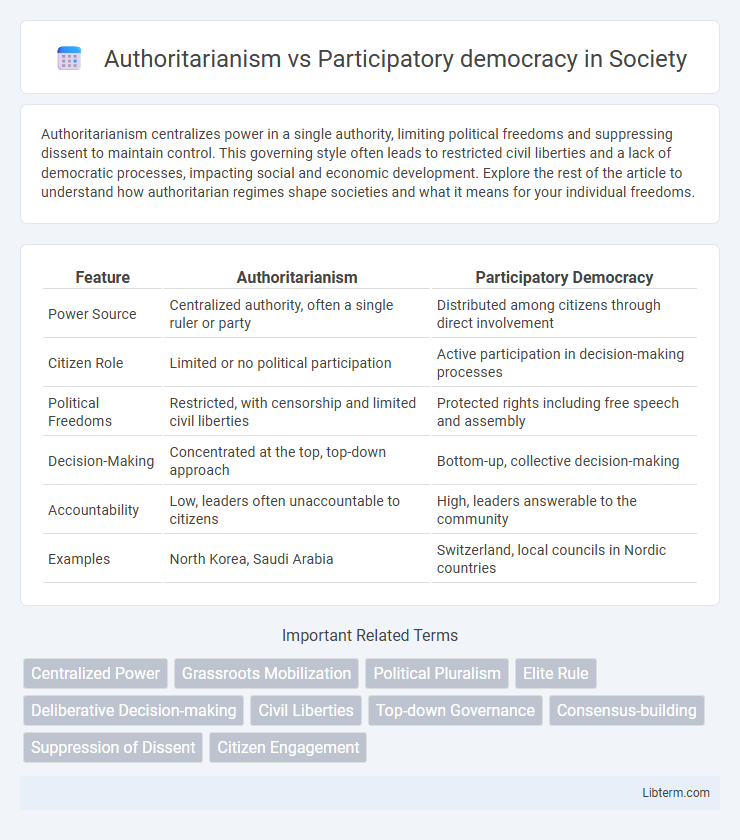Authoritarianism centralizes power in a single authority, limiting political freedoms and suppressing dissent to maintain control. This governing style often leads to restricted civil liberties and a lack of democratic processes, impacting social and economic development. Explore the rest of the article to understand how authoritarian regimes shape societies and what it means for your individual freedoms.
Table of Comparison
| Feature | Authoritarianism | Participatory Democracy |
|---|---|---|
| Power Source | Centralized authority, often a single ruler or party | Distributed among citizens through direct involvement |
| Citizen Role | Limited or no political participation | Active participation in decision-making processes |
| Political Freedoms | Restricted, with censorship and limited civil liberties | Protected rights including free speech and assembly |
| Decision-Making | Concentrated at the top, top-down approach | Bottom-up, collective decision-making |
| Accountability | Low, leaders often unaccountable to citizens | High, leaders answerable to the community |
| Examples | North Korea, Saudi Arabia | Switzerland, local councils in Nordic countries |
Defining Authoritarianism: Core Principles and Features
Authoritarianism is characterized by centralized power, limited political freedoms, and restricted individual rights, where decision-making authority rests with a single ruler or a small elite. Core features include the suppression of political opposition, controlled media, and minimal public participation in governance. This system emphasizes obedience and conformity over political pluralism and democratic accountability.
Understanding Participatory Democracy: Key Concepts
Participatory democracy centers on active citizen engagement in decision-making processes beyond voting, emphasizing direct involvement in policy development and community governance. Key concepts include inclusivity, where diverse voices shape outcomes, and deliberation, fostering informed discussions to reach consensus. This form of democracy contrasts with authoritarianism by promoting transparency, accountability, and shared power among citizens rather than centralized control.
Historical Origins of Authoritarian and Participatory Systems
Authoritarianism traces its historical origins to ancient monarchies and empires where centralized power was maintained by rulers without public consent, exemplified by the autocratic rule of Roman emperors and medieval kings. Participatory democracy emerged from classical Athens, where citizens directly engaged in decision-making processes, laying the groundwork for modern democratic principles emphasizing active citizen involvement. The evolution of participatory systems contrasts sharply with authoritarian regimes, reflecting fundamentally different views on political power distribution and public participation.
Power Dynamics: Centralization vs Decentralization
Authoritarianism centralizes power in a singular authority, limiting public influence and controlling decision-making processes to maintain order and hierarchy. In contrast, participatory democracy disperses power across communities, encouraging active citizen engagement and collaborative governance to enhance transparency and accountability. The tension between these models highlights the impact of centralized control on individual freedoms versus decentralized empowerment fostering collective ownership.
Citizen Engagement in Governance: Silence or Voice?
Authoritarianism limits citizen engagement by centralizing power and suppressing public dissent, resulting in a predominantly silent populace with minimal influence on governance decisions. In contrast, participatory democracy actively encourages citizen involvement through mechanisms like public consultations, referenda, and grassroots activism, ensuring diverse voices shape policy outcomes. The degree of civic participation directly impacts transparency, accountability, and the legitimacy of governing institutions in both systems.
Decision-Making Processes: Top-Down vs Bottom-Up Approaches
Authoritarianism relies on top-down decision-making processes where authority is centralized, and decisions are made by a few individuals or elite groups without broad public input. Participatory democracy emphasizes bottom-up approaches, encouraging active citizen involvement and collective deliberation in policy formulation and governance. This fundamental difference shapes responsiveness, accountability, and the distribution of political power in each system.
Impacts on Human Rights and Civil Liberties
Authoritarianism often leads to the suppression of human rights and the curtailment of civil liberties, as centralized power discourages dissent and limits freedom of expression. Participatory democracy, by contrast, promotes accountability, transparency, and the protection of individual freedoms through active citizen involvement and inclusive governance. Empirical studies indicate that countries with participatory democratic systems typically exhibit stronger legal protections for human rights and higher levels of civil liberty enforcement.
Economic Performance Under Each System
Authoritarian regimes often implement centralized economic policies that enable rapid decision-making and large-scale infrastructure projects, potentially boosting short-term growth but risking inefficiencies and corruption. Participatory democracies encourage broader citizen engagement in economic policymaking, fostering transparency, accountability, and long-term sustainable development despite slower decision processes. Empirical data indicates that while authoritarian systems may achieve high GDP growth rates initially, participatory democracies tend to sustain more consistent economic performance and equitable wealth distribution over time.
Societal Stability and Conflict: Comparing Outcomes
Authoritarianism often maintains societal stability through centralized control, suppressing dissent and limiting political freedoms, which can reduce overt conflict but may foster underlying tensions. Participatory democracy encourages active citizen engagement, promoting transparency and accountability that can address grievances peacefully but may lead to increased visible conflict due to diverse opinions and open debate. Studies show societies with participatory democratic frameworks experience more sustainable long-term harmony by resolving conflicts through inclusive dialogue, whereas authoritarian regimes risk abrupt instability when suppressed conflicts eventually surface.
Global Trends: The Future of Governance Models
Authoritarianism remains prevalent in regions prioritizing centralized control and political stability, often at the expense of civil liberties and public participation. Participatory democracy is gaining momentum globally, driven by digital technologies enabling citizen engagement and transparent decision-making processes. Future governance models are likely to blend elements of both systems, leveraging authoritarian efficiency alongside participatory inclusiveness to address complex socio-political challenges.
Authoritarianism Infographic

 libterm.com
libterm.com